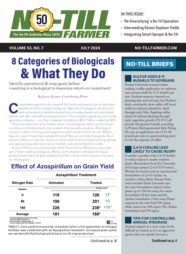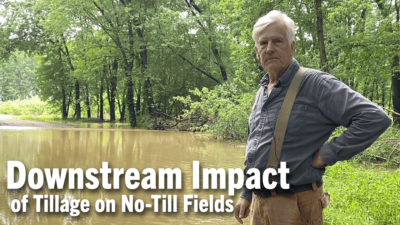Updated May 6, 2024
Sustainable Aviation Fuel Tax Credit Requirements Could Be 'Biggest Soil-Saving Event of Century'
No-till veteran Guy Swanson says changes to a U.S. tax credit could be the "single biggest soil-saving event of the century."
Swanson, who's also an engineer at Exactrix, a company that makes green ammonia systems, commented on the 40B notice over the weekend. The notice includes the USDA Climate Smart Agriculture practices for corn and soybeans grown for ethanol, and requires the use of no-till, cover crops and enhanced efficiency nitrogen fertilizer as part of the qualification model.
"This is a gift to certain farmers who store soil carbon in no-till," Swanson says. "It is a gift to ethanol. It is a gift to Exactrix, and 50 years of a better way to farm no-till with low or no carbon inputs."
Swanson talked at length to No-Till Farmer about the updates, and a podcast episode with his insights is available May 11.
Updated May 3, 2024
No-Till, Cover Crops, Efficient Fertilizer Required for Ethanol Tax Credit
Federal incentives to lower greenhouse gas emissions could result in a windfall for no-tillers who are already raising low-carbon corn. The U.S. Department of the Treasury and IRS released a notice April 30 that details an updated version of the Greenhouse Gases, Regulated Emissions and Energy Use in Transportation (GREET) model, which is used to determine carbon intensity scores of corn used for sustainable aviation fuel (SAF).
SAF sold or used between Dec. 31, 2022, and Jan. 1, 2025, is eligible for an income tax credit under Section 40B, created in the Inflation Reduction Act. In order to qualify, the mixture must produce at least 50% less greenhouse gas emissions over its lifecycle as compared to petroleum-based jet fuel. Once the SAF meets the 50% threshold, the percentage of greenhouse gas reduction is used to calculate the income tax credit.
“The supplemental amount increases the $1.25 base tax credit by 1 cent for each whole percentage point by which the lifecycle greenhouse gas emissions reduction percentage exceeds 50%,” write attorneys at Holland & Knight. “The maximum increase is 50 cents, capping the total credit at $1.75 per gallon. For these reasons, how to determine lifecycle greenhouse gas emissions reduction of the SAF is of utmost interest.”
USDA Climate Smart Agriculture Definitions
The April 30 notice includes the USDA Climate Smart Agriculture (CSA) practices for corn and soybeans grown for ethanol and uses these guidelines for the updates. Below is information from the Pilot Program for Certain Climate-Smart Agriculture Practices:
No-Till Requirements
In order for the corn to qualify, farmers must use no-till, plant cover crops and apply enhanced-efficiency nitrogen fertilizer on the entire acreage on which each CSA crop is grown. Soybeans qualify if they are no-tilled and the field is cover cropped.
The USDA’s CSA pilot program defines no-till as “limiting soil disturbance to manage the amount, orientation and distribution of crop and plant residue on the soil surface year-round.”
Annual criteria include:
- Residue must not be burned.
- Distribute all residues uniformly over the entire field. Removing residue from directly within the seeding or transplanting area prior to or as part of the planting operation is acceptable.
- This practice only allows an in-row soil disturbance operation during strip tillage, the planting operation, and a seed row/furrow closing device. Full-width soil disturbance is disallowed from the time immediately following harvest or termination of one cash crop through harvest or termination of the next cash crop in the rotation regardless of the depth of the tillage operation. The soil tillage intensity rating (STIR) value must include all field operations that are performed during the crop interval between harvest and termination of the previous cash crop and harvest or termination of the current cash crop (includes fallow periods). The crop interval STIR value must be no greater than 20.
Cover Crop Requirements
In the SAF context, USDA defines cover crops as grasses, legumes and forbs planted for seasonal vegetative cover. Annual criteria for covers include:
- Plant species, seedbed preparation, seeding rates, seeding dates, seeding depths, fertility requirements, and planting methods must be consistent with applicable local criteria and soil/site conditions.
- Select species that are compatible with other components of the cropping system.
- Ensure herbicides used with crops are compatible with cover crop selections and purpose(s).
- Cover crops may be established during the fallow season prior to planting the feedstock crop, or companion planted or relay-planted into production crops.
- Must not burn cover crop residue.
- Determine the method and timing of termination to meet the grower's objective and the current NRCS Cover Crop Termination Guidelines.
- When a cover crop will be grazed or hayed, ensure the planned management will not compromise the soil health and organic matter content.
- Do not harvest cover crops for seed.
- If the specific rhizobium bacteria for the selected legume are not present in the soil, treat the seed with the appropriate inoculum at the time of planting.
Enhanced Efficiency Nitrogen Fertilizer (EENF)
Enhanced efficiency fertilizers are products with characteristics that allow increased plant uptake and reduce the potential of nutrient losses to the environment (for example, gaseous losses, leaching, or runoff) when compared to a reference product, according to the CSA definition. The pilot focuses on EEFNs because nitrogen is the primary carbon intensity-relevant nutrient.
The CSA practice document uses three strategies for EENF practices, and the farmer must implement one of the three to fulfill EENF requirements. For all strategies, the EENF must serve as at least 50% of the nitrogen source for the production of the feedstock.
Strategy 1: EENF that contain nitrification inhibitor products resulting in delayed nitrification processes, by eliminating the bacteria Nitrosomonas in the area where ammonium is to be present.
- Materials must be defined by the AAPFCO and be accepted for use by the State fertilizer control official, or similar authority, with responsibility for verification of product guarantees, ingredients (by AAPFCO definition) and label claims.
- Application timing, method, nitrogen source, soil texture, and tillage regime are all factors that should be evaluated to determine where nitrification inhibitors should be used. Before buying an inhibitor make sure scientific evidence backs up all claims. Producers and/or consultants should be wary of any product that does not have solid scientific data demonstrating that the inhibitor activity matches the advertised benefit.
- EENF products must be recommended by LGU and concurred with by NRCS on all treatment acres to supply at least 50% of the pre-emergent and early post emergent LGU recommended nitrogen budget requirements for the crop(s) grown. Common chemical products used to interrupt the nitrification process include dicyandiamide (DCD) and 2chloro-6 (trichloromethyl) pyridine.
Strategy 2: EENF products that contain urease inhibitor products to temporarily reduce the activity of the urease enzyme and slow the rate at which urea is hydrolyzed.
- Materials must be defined by AAPFCO and be accepted for use by the State fertilizer control official, or similar authority, with responsibility for verification of product guarantees, ingredients (by AAPFCO definition) and label claims.
- Application timing, method, nitrogen source, soil texture, and tillage regime are all factors that must be evaluated to determine where urease inhibitors should be used. Before buying an inhibitor make sure scientific evidence backs up all claims. Producers and/or consultants should be wary of any product that does not have solid scientific data demonstrating that the inhibitor activity matches the advertised benefit.
- EENF products must be recommended by LGU on all treatment acres to supply at least 50% of the pre-emergent and early post emergent LGU recommended nitrogen requirements for the crop(s) grown.
- Common chemical products that are known to affect urease formation are N-(n-butyl) thiophosphoric triamide (NBPT) and ammonium thiosulfate (ATS).
Strategy 3: Slow-release or controlled release formulations of nitrogen fertilizer/EENF for at least 50% of the pre-plant and/or post emergent applications.
- Use of slow-release or controlled-release nitrogen fertilizer products to improve nutrient use efficiency.
- Uncoated Nitrogen Fertilizers include: ureaformaldehyde (UF) reaction products, ureaform and methylene ureas.
- Coated Nitrogen Fertilizers include: sulfur-coated fertilizers, polymercoated fertilizers and polymer/sulfur coated fertilizers.
Recordkeeping Requirements
Farmers need to document their management and field operations for both no-till and cover crops. Before implementing EENF, farmers must develop and document a planned nutrient budget, yield goal and applications of nitrogen, phosphorus and potassium. Farmers must also provide management records demonstrating their actual nutrient applications, records of their EENF purchase and more. The pilot program also outlines the supply chain traceability requirements and recordkeeping for the SAF producer.
Impact on 45Z Tax Credit
As No-Till Farmer has reported, the U.S. 45Z Clean Fuels Production tax credit is another opportunity for no-tillers to profit from government incentives for SAF. The tax credit can reach up to $1.75 a gallon, starting Jan. 1, 2025, until the end of 2027, according to Progressive Farmer.
"The guidance provided by the Treasury Department is going to provide a clear pathway to how best to qualify for the 40B tax credits, and it is also going to create a process to expand opportunities under 45Z," says U.S. Agriculture Secretary Tom Vilsack.
Mitchell Hora, Washington, Iowa, no-tiller and founder of Continuum Ag, says no-tillers should take proactive measures to calculate their carbon intensity score, and organize and verify their data to maximize their opportunity.
With 45Z, Hora believes corn growers have an unprecedented opportunity to share in what many would term an industrial tax credit windfall.
“This is one of today’s biggest opportunities in ag — particularly conservation ag,” he says. “The folks with data — the agronomist, the team around each farmer — we all need to be working together with the folks at the biofuel facility to go after these credits together. Let’s maximize this opportunity and make certain we have an equitable share of those dollars throughout the ag supply chain, with farmers who are contributing getting paid their fair share.”
The big influencers for lowering a crop’s CI include cover crop use, reduced tillage or no-till, nitrogen fertilizer use, field-by-field yield figures, diesel fuel consumption throughout the crop’s season and overall energy use. These practices likely sound familiar to no-tillers using them to build soil health and lower costs — and an operation’s carbon footprint.
“We need to document all of these practices to determine — and lower — our production CI score,” Hora says. “The better the score, the more you help the biofuel company meet its goals, the more credits it can earn, and the more money they could pass along to you. When an ethanol plant buys our family’s corn to produce ethanol, we are selling them carbon-negative corn, which offsets the plant’s carbon footprint. Now they are producing very low CI-score ethanol, which qualifies for the 45Z tax credit of $0.02 per gallon per CI point reduction.”
The corn on Hora's family farm has a CI score of -10, which is likely worth $500 an acre growing 240-bushel yields.
“That’s the total pie,” he says. “I’m not going to get $500 per acre, and the ethanol guy is not going to get $500 per acre. But if we aren’t willing to negotiate, neither of us will get anything.”
At 250 bushels per acre, $500 indicates a “pie” of $2 per bushel, Hora says.
“I don’t know what my cut is going to be,” he says. “I don’t think I should get 10 cents, and I don’t think I’m going to get $1.90, but it will be somewhere in the middle.”
Tax expert Paul Neiffer doesn't share Hora's optimism, however.
“In my opinion, this is essentially worthless for most corn and soybean farmers to get any value out of this since almost no farmers will meet the safe harbor," Neiffer wrote to Pro Farmer. "As I mentioned in the post for 2024, a SAF producer should just import Brazil sugar ethanol, take the IRS credit and move on. They need to make it easier for 2025 for the Section 45Z credit or this will not work. I hope I am wrong, but I don’t think so.”
Farm Groups Unhappy with Changes
The changes were met with mixed reaction from farm groups, lawmakers and biofuel groups. Sen. Chuck Grassley (R-Iowa) cited two issues with the GREET model, saying the new formula would be easy to violate and won't allow for enough feedstock to make all the SAF needed.
“To put it bluntly, this GREET Model update is a stupid approach," Grassley says. "Widespread use of Sustainable Aviation Fuel will help fight global warming. But rejecting grain feedstocks will impede efforts to produce that fuel on a commercial scale. Some people might argue this decision won’t impact farmers’ bottom lines, because they can sell their corn and soybeans elsewhere. That’s hogwash, and it shows the people saying it don't know much about how farmers deliver their grain. These new barriers to entry will strip farmers of a significant market opportunity.”
Meanwhile, biofuels groups generally thought the guidance was a step in the right direction.
“Biodiesel, renewable diesel and SAF producers are already negotiating feedstock and fuel offtake contracts for 2025, so we look forward to working with Treasury and USDA to quickly turn attention to guidance for the Clean Fuel Production Credit that begins Jan. 1 next year,” says Kurt Kovarik, vice president of federal affairs for Clean Fuels Alliance America. “We believe there are additional climate smart agriculture practices and industry data that can be incorporated in the GREET model to support the continued sustainable growth of the entire clean fuel industry.”
“This marks the first time a regulatory body has formally acknowledged the role CSA practices play in reducing corn ethanol’s greenhouse gas emissions, in this case enabling some ethanol-to-jet to qualify for the 40B credit," says Brian Jennings, CEO of the American Coalition for Ethanol. “We are very encouraged the 40B GREET determination of indirect effects, including the land use change penalty for ethanol-to-jet, was driven by science rather than arbitrarily inflated estimates which do not reflect real-world observations of land use and conversion. While today’s announcement is a step in the right direction, corn farmers and ethanol producers will face headwinds to produce qualifying corn ethanol feedstock for SAF given the all or none requirement to bundle CSA practices."
Several commodity groups also raised concerns with the no-till and cover crop requirements.
“We are deeply disappointed that this updated model requires farmers to implement environmental practices that are not practical for all acres of the large and varied geographic region in which corn is grown,” says Minnesota farmer and NCGA President Harold Wolle. “This requirement in GREET will significantly hinder the chances corn growers have in accessing the sustainable aviation fuel market, even as higher blends of corn ethanol offer great promise in the country’s fight against greenhouse gas emissions and climate change. As corn growers, we already understand the environmental practices that work best for our growing conditions and climate, so it is not necessary for the government to dictate specifically how we reach an emissions reduction goal. Farmers are going to have different methods depending on a variety of factors, including where their farms are located.”
A statement from the American Soybean Association says the new guidance "sweetens the value" for soybeans but "goes sideways" with the no-till and cover crop requirement.
“For growers like me here in North Dakota, short growing seasons and unpredictable fall weather make the cover crop requirement alone next to impossible," says Josh Gackle, American Soybean Association president and Kulm, N.D., farmer. "Growers in the Northern Plains do so when possible. However, employing both no till and cover cropping is contrary to what Mother Nature will allow, no matter what the guidance specifies.”
"Acknowledging, for the first time, the carbon benefits that climate-smart agriculture practices can deliver is a significant step to ramping up SAF production, and National Oilseed Processors Association (NOPA) is pleased to see the updated GREET model recognize the positive environmental impact of U.S.-produced biofuels," says Kailee Tkacz Buller, NOPA president and CEO. “However, we are concerned the requirement to implement climate-smart ag practices simultaneously will limit this opportunity, particularly in parts of the country where it may not be possible to plant a cover crop or the cost to implement new practices is too steep."








Post a comment
Report Abusive Comment